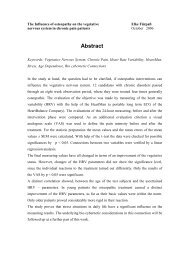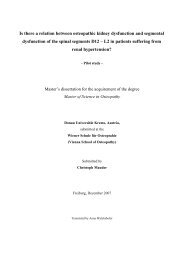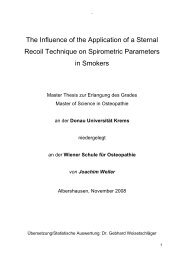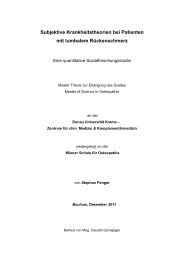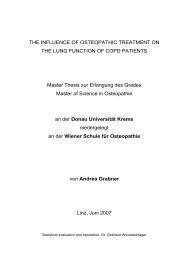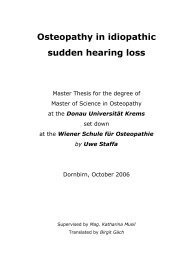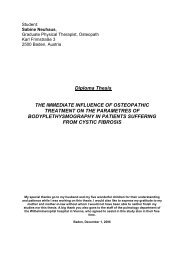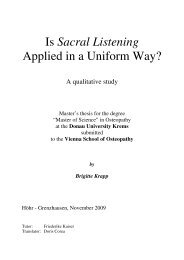Can back pain caused by symptom-giving sacroiliac joint relaxation ...
Can back pain caused by symptom-giving sacroiliac joint relaxation ...
Can back pain caused by symptom-giving sacroiliac joint relaxation ...
You also want an ePaper? Increase the reach of your titles
YUMPU automatically turns print PDFs into web optimized ePapers that Google loves.
1. Background<br />
1.1. Anatomy<br />
1.1.1. The <strong>sacroiliac</strong> <strong>joint</strong> (SIJ)<br />
The pelvic girdle is an articulated bony ring composed of the left and right coxal bone<br />
and the sacrum. These three bony parts are dorsally joined <strong>by</strong> the two <strong>sacroiliac</strong><br />
<strong>joint</strong>s (SIJs) and ventrally <strong>by</strong> the pubic symphysis. Even though this anatomic<br />
structure has to assure high stability, the pelvis shows a certain inherent mobility<br />
which plays an essential role in the birth process. [58]<br />
No consensus has been reached so far regarding the anatomic classification of the<br />
SIJs. This may be due to the fact that in former times it was assumed that the SIJs<br />
did not have any mobility at all. This assumption was based on findings of in vitro<br />
studies of preparations of older persons where SIJs have been ankylosed already<br />
[24].<br />
One part of the <strong>joint</strong> region can be<br />
described as a diarthrosis. It is a<br />
synovial <strong>joint</strong> composed of the <strong>joint</strong><br />
cavity, <strong>joint</strong> capsule, ligaments and<br />
<strong>joint</strong> partners covered with hyaline<br />
cartilage. The first one to describe this<br />
<strong>joint</strong> as above was Von Luschka in<br />
Fig. 1A: Transverse section of SIJ [24]<br />
1854 [63]. [24, 58]<br />
If the dorsal aspect between the ilium<br />
and the sacrum, which is filled with the interosseous <strong>sacroiliac</strong> ligaments, is seen as<br />
one separate part of the SIJ, this part of the <strong>joint</strong> can be described as a<br />
syndesmosis. [7]<br />
Master’s Thesis Wolfgang Aspalter 11



